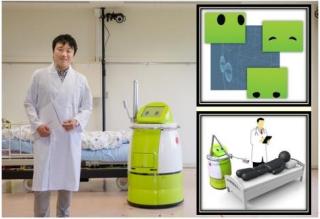May 29 2015
Given the aging of the population and the low birthrate both in Japan and elsewhere, healthcare professionals are in short supply and unevenly distributed, giving rise to a need for alternatives to humans for performing simple tasks.
 This image shows the Terapio medical round support robot. Credit: Copyright (c) 2015 Toyohashi University of Technology. All Rights Reserved.
This image shows the Terapio medical round support robot. Credit: Copyright (c) 2015 Toyohashi University of Technology. All Rights Reserved.
Although increasing numbers of medical institutions have introduced electronic medical records, a variety of issues remain unresolved, such as the inconvenience of data recording and the high costs associated with data input.
The use of robots to support medical care data management and the delivery of resources at the medical front--thus allowing humans to concentrate on those tasks requiring knowledge, skill, and experience--is expected to contribute to the enhancement of the quality of healthcare services.
Now, researchers at Toyohashi Tech have developed "Terapio," a next-generation robot that replaces the conventional medical cart used by healthcare staff during their rounds in a hospital.
Terapio assists staff in delivering resources and recording round information with its friendly communication abilities.
Terapio is an autonomous mobile robot that can track a person. It uses a differential-drive steering system to provide both quiet operation and smooth omnidirectional mobility. It recognizes its environment and autonomously tracks a specified human while avoiding obstacles. Using the Terapio's ring-shaped power-assist handle, an operator can control the robot accurately by applying a slight force. Terapio can also record patients' personal and vital signs data and also display data, such as the patient's health records. In terms of its exterior design and color scheme, Terapio is suitable for use in medical institutions. The touch panel on the top of Terapio is used for operating the robot and inputting/displaying round data. It is designed such that the operator and patient can recognize the robot's status and actions by expressions shown on the display that change according to the robot's operation mode, which are "power assist," "tracking," and "rounds."
The LCD display on the top of Terapio serves as the robot's "face." It changes its expression by changing the shape of its "eyes." Unlike the metallic, cold impression of a cart, these eyes give Terapio a human-like, friendly, and communicative persona.
"As we were developing Terapio, we could clearly imagine the human-robot symbiosis. By constantly promoting the pursuit of system integration technology, life with robots will be a reality in the near future," said assistant professor Ryosuke Tasaki. "An ongoing daily effort to incorporate high-tech robotics into our activities will be the best way to realize life in our future society."
When medical and nursing care workers are released from menial and back-breaking work by sharing their duties with a robot, they will be able to concentrate more on interacting with their patients and providing knowledgeable, kind, and compassionate care. Terapio can also elicit warmth from the humans with which it interacts. The researchers expect that similar research will become widespread in the future as more people adopt a conciliatory approach to human-robot symbiosis.